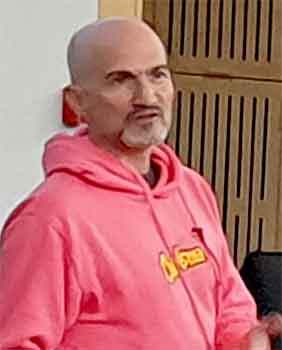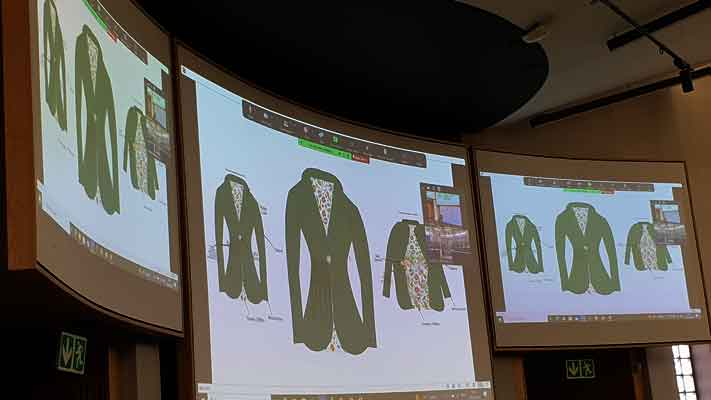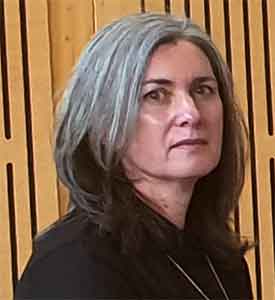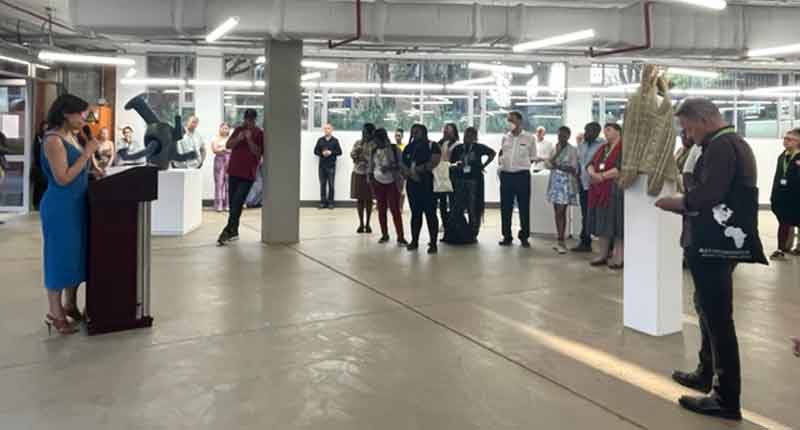Day 2: Higher Education

Fouad Asfour: When bodies trans-language multimodally - Exploring trans-lingual aspects through visual writing
This paper is part of a creative research PhD thesis based on collaborative writing processes with South African visual artists and writers. It is based on the observation that little attention is paid to translanguaging practices in South African visual artists’ and writers’ practices. Thus, it aims to fill a gap in knowledge production about multilingual aspects in South African discourse (including the Global South) around writing and/in visual art. The research aims to explore the entanglement of desire, conformity, and resistance in translingual writing (Asfour et al. 2020), asking: How do multilingual visual artists activate the expanded field of writing across media, practices, and languages in their work? How can linkages between orality and writing speak across disciplines, identities and languages and facilitate processes of epistemological becoming? How can we embody diverging ‘orientations’ (Ahmed) in writing, turning language into “trans-languaging”? The paper argues that ‘writing in the expanded field’ (Krauss 1978) can form the basis for extended conceptual repertoires that allow for activating trans-languaging as epistemological becoming. It is based on writing as visual practice, both as line, form, and techné (Kristeva 1984) and collaborative writing praxes as collaborative knowledge-making. It further aims to explore how experimental translingual writing/text can inform artistic practices further and contribute to contemporary academic South African discourse (not limited to visual art discourse). Drawing from creative writing practices, it proposes translingual writing as “Spectography”, investigating the spectrality of silences of first languages (Peterson 2019) through facilitating writing groups (Rhodes University 2017-19, Wits 2020-ongoing). The research process is based on collaborative explorative labour of writing, sharing experiences through and in writing (in and about languages) through creative writing exercises. In this framework, participants engage in (visual and performative) experimental writing, activated by memory work, linguistic biographies (Busch et al 2003) and bio-mythography. It aims for artists, writers, educators and practitioners to activate translanguaging through reflecting on and practising writing as embodied memory – through the practice of working and writing in/across languages, and to engage in collaborative learning through writing as creative (visual) practice.
Isadora Canela / Elsa Cuissard: ToT – Art & education project: Challenging hierarchical knowledge systems for migrants and refugees
A significant challenge faced by migrants and refugees is the underestimation and devaluation of their prior knowledge and experiences, often overshadowed by dominant Western ways of living. Recognizing harm caused by those structures, ToT highlights the urgency for alternative approaches. Embracing micropolitics and affection as political statements, ToT creates a safe and horizontal space, enabling the collective creation of narratives and worlds through art, functioning as a form of resistance against existing power dynamics. ToT reclaims art and education as powerful tools to challenge and transform oppressive and colonizing systems of hierarchical knowledge. Establishing a horizontal, decolonial, and careful web of exchange, through organic formats for knowledge sharing, ToT valorizes diverse skills and backgrounds through collective teaching-sharing-learning. The diverse group formed by women and queer, representing over 10 nationalities, fosters a shifting of political power within this living microsystem. Therefore, ToT is structured in 2 Stages: 1. online sessions aimed at learning from and exchanging ideas among the group, and exploring interdisciplinary perspectives, with guest mediators from various fields including the EVC collaborators. 2. Each participant led their workshops in person in Berlin and, from there, co-created a collective exhibition, by merging approaches to knowledge dissemination, artistic expression, and community engagement.

Jane Awuor Otieno: Rethinking pottery for community building and artistic engagement of women inmates, Lan’gata prison, Kenya
The paper will investigate art programmes as a rehabilitative intervention among female prison inmates in Lang’ata women's prison in Kenya. The purpose of this paper is to determine the effectiveness of art programmes offered in women's prisons in Kenya to aid in integrating inmates into society. Ineffective rehabilitation of women inmates remains one of society’s concerns all over the world, Kenya included. Studies have shown that art programmes in prisons can make offender rehabilitation successful. However, few studies have examined women offenders in Kenya, and to a lesser extent the art programmes as rehabilitative tools that address their reintegration. Art programmes in prisons provide inmates with various skills that make them feel valued. The feelings of appreciation help to change the inmates’ perspectives of themselves and their life in general. This paper will explore the literature on the connections between art programmes and the rehabilitation of women inmates. For the collection and analysis of information, online sources of peer-reviewed scientific journals in addition to the earlier art project done in prison will be used. Recommendations of the proposed situation analysis will seek to contribute to the information in aiding in the integration of trained women inmates back into society through the art programme.

Esther Kute (Online): A reflection on the EVC Gender Matters Exhibition Projects
We experience complex historical, socio-economic, environmental and political challenges in our worlds, which require us to explore educational approaches that sufficiently prepare designers to address these complexities. In this paper, the author posits that practice-based design learning provides the educational foundation required to prepare students to design for these complexities. To support this position, the author reflects on the practice-based design learning pedagogical approach used in guiding students from the Technical University of Kenya to develop term-based projects for submission to the EVC Gender Matters exhibition. Observations of student’s attitudes towards the subject matter are reviewed and explored; seeking insights on how contemporary student designers in Kenya can be guided towards adding knowledge to conversations around commonality, diversity, and our histories in the cultural world. Aspects of the projects including concept development, the design and production process, facilitation and outcomes are also discussed. Data, analysis, conclusions and insights will be based on participant observation, and extensive reading combined with structured and unstructured research.

Lydia Muthuma: Indigenous art - paintings in the Lodwar Catherdral
By focusing on a body of art that was produced for an indigenous community, this paper offers a critique of the binary approach between indigenous knowledge and Western worldviews. Western knowledge relies on established laws through the application of the scientific method to phenomena (2018, Maluleka et al.) while indigenous or African traditional knowledge comprises understandings, skills and philosophies developed by societies with long histories of interaction with their natural surroundings (2022, UNESCO LINKS). The unsustainability of a structural binary opposition that contrasts one knowledge system to the other, is the subject of this paper. And, the chosen illustration is a collection of religious art, the Stations of the Cross in the Lodwar Cathedral, Kenya. The paintings were executed in
response to the 1995 synod of African Bishops. They depict present day Turkana subjects re-living Jesus Christ’s 2000-year-old narrative. Critical questions are posed for the reader: should we consider the paintings indigenous or Western? Subsequently, how to archive them –within or without the local indigenous knowledge systems?

Mary Clare Kidenda: Recognition of Prior Learning in the Jua Kali Sector in Kenya - Making knowledge, skills and competencies visible
The structure of the colonial education system left many Kenyans with significant gaps in their education, training and development, leading to inequality of opportunities, illiteracy and unemployment. Skills development outcomes in Kenya have not met the market needs resulting in a large informal or Jua Kali sector whose integration into the national development agenda needs to be articulated. The sector is characterised by its grassroots nature, where many individuals have acquired valuable skills and knowledge through practical experience and on-the-job training. The majority lack formal qualifications or recognised certificates. Because of this realisation, this paper looks at one of the functions of the Kenya National Qualifications Authority, which is to promote access and equity in education and training by providing pathways that support the development and maintenance of flexible access to qualifications by recognising experiential learning. This paper will articulate how recognition of prior learning can provide a pillar underpinning the process and make visible the skills and competencies of Jua Kali artisans, how they can be assessed and certified for purposes of improved employability, alternative access and admission, societal recognition, mobility and self-esteem through education in tertiary institutions.

Jenni Lauwrens: Exploring visual cultures through the non-visual senses
While ‘exploring visual cultures’, let us not forget the non-visual senses. In the early 1990s, as the seeds of visual culture studies were being sown in academic scholarship, sensory anthropologists and sensory historians cautioned against a visually reductive approach to art and culture (Howes 2005, Halsall 2004). They also pointed out that, in assisting the ‘dominating male gaze,’ the so-called ‘objective’ visual sense has a long association with masculinity, rationality and ‘clear and distinct’ knowledge. Conversely, the so-called “lower” senses of touch, smell, and taste were historically associated with non-rational sensuality, femininity and the lower classes (Classen 2017). The limitations of a purely visualist approach to understanding visual culture have now been well-documented (see Howes 2022). To overcome these limitations, a sensory approach or sense-based inquiry is necessary. By shifting the focus to smell, taste, sound, and touch, sensory art historians and sensory visual culturalists can go beyond the visual to uncover additional knowledge about artworks and cultural objects, as well as their reception. In their hands, new histories and narratives about familiar objects that were previously only analyzed through visualist lenses, might be produced. In this presentation, I will contextualize the sensory approach to art and visual culture within what is now commonly known as the ‘sensory turn’ (Bull, et al 2006) and discuss selected projects that take a multisensorial approach to exploring visual culture.
Another Roadmap Africa Cluster @ Javett-UP Art Centre



